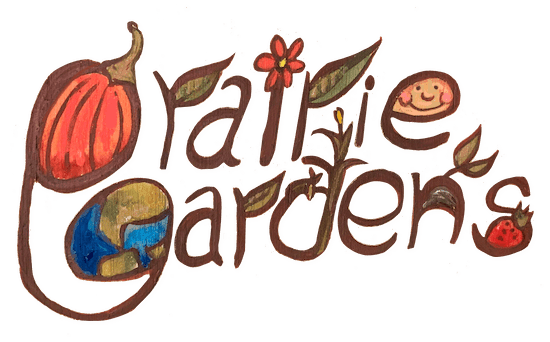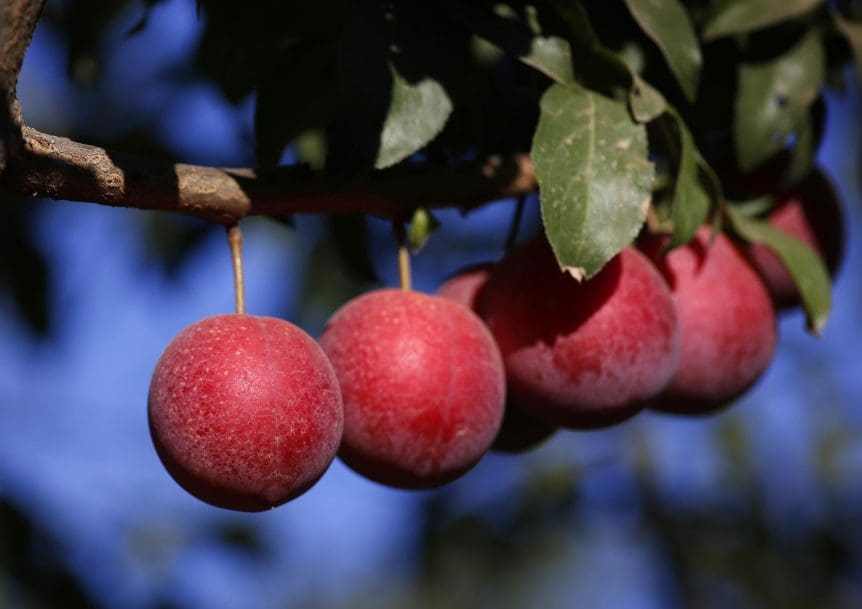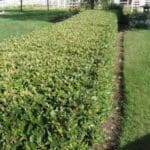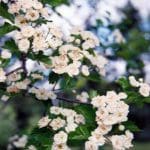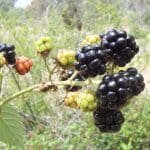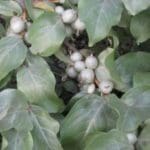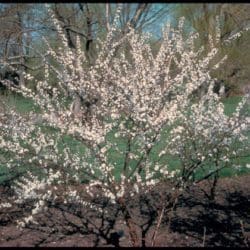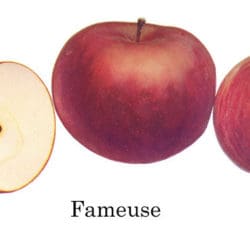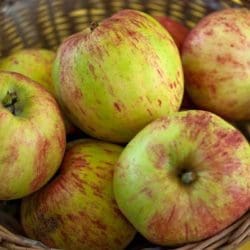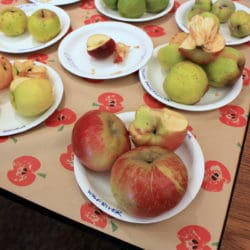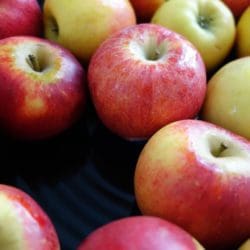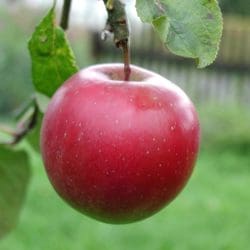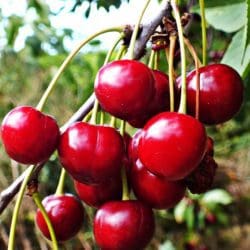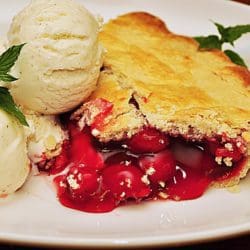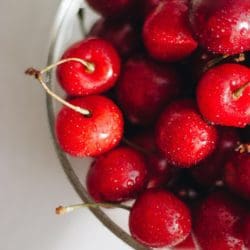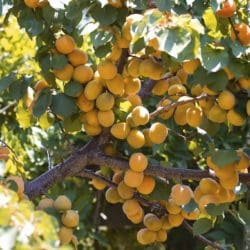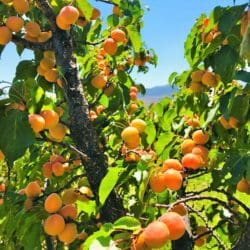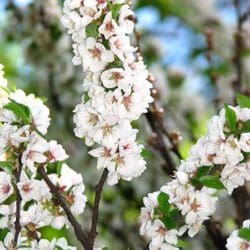In-depth Fruit Tree Planting Tips for the Home Garden in Alberta
The following suggestions will help you to successfully plant fruit trees in Canadian Hardiness Zones 0 to 4 for Alberta gardens, whether it is spring, summer or fall, and you’ll have an in depth understanding on how to grow hardy fruits in the north!
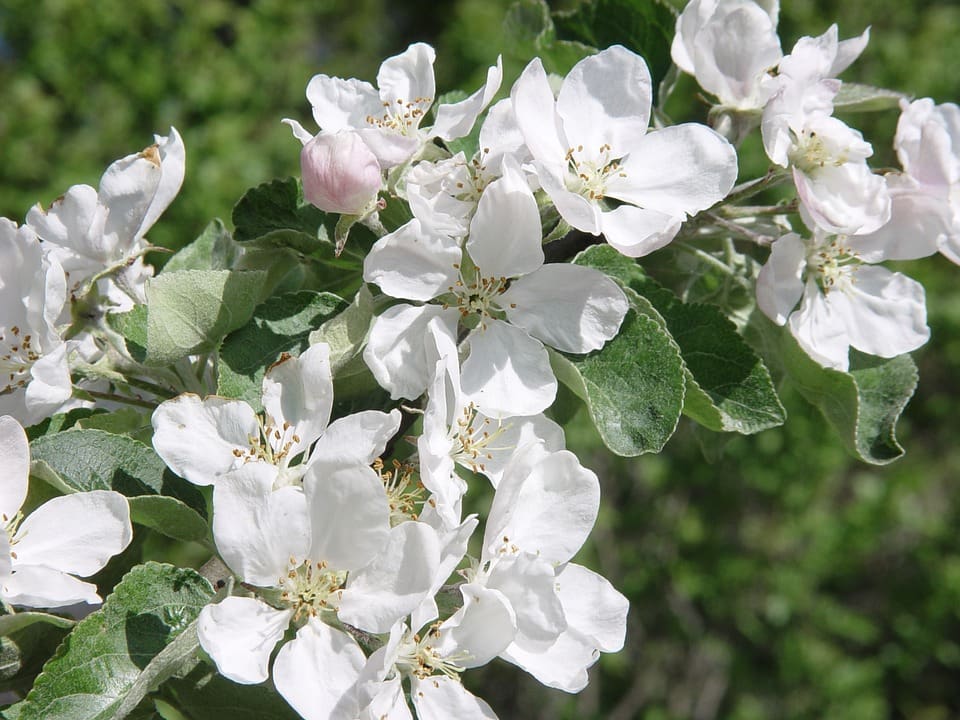

Apple Tree Blossoms
Spring Planting
Springtime is the ideal planting time for fruit trees in Alberta. They can be planted as soon as the frost is out of the ground, so you can get your shovel into the earth – to dig the planting hole. Across Alberta, this can range anytime from mid to late April through June. Apples, plums, pears, apricots, tart cherries, and berries planted in this spring will get you one step closer to saving money on your grocery bills, and becoming self-reliant on your own property.
Fruit trees and berry bushes planted this spring will, in a few years, provide us nourishing harvests; harvests that you will enjoy with your children; harvests that, with the right care of our trees, will nourish their children as well. Centurions, or 100-year-old apple trees will still give your family apples in 2124!
It’s a joyful experience to picking a ripe apple, a handful of tart cherries, or succulent juicy plums right off the tree – to enjoy right there under the tree, in your own orchard. The fastest growing fruit are day-neutral strawberries – planted the first week of May – they will give you ripe strawberries to pick-your-own for your family by mid-July this year.
When I Expect Fruit?
Haskaps, Raspberries, Currants and Saskatoons are next, you’ll pick a little fruit by year two. By year three, you’ll start to pick precocious (early to fruit) apples, and tart cherries! By year seven – pretty much all the berry crops are in full production. And the plums, and pears are mature enough to start fruiting. It’s an investment that pays off in bushels of fruit if you take good care of your trees.
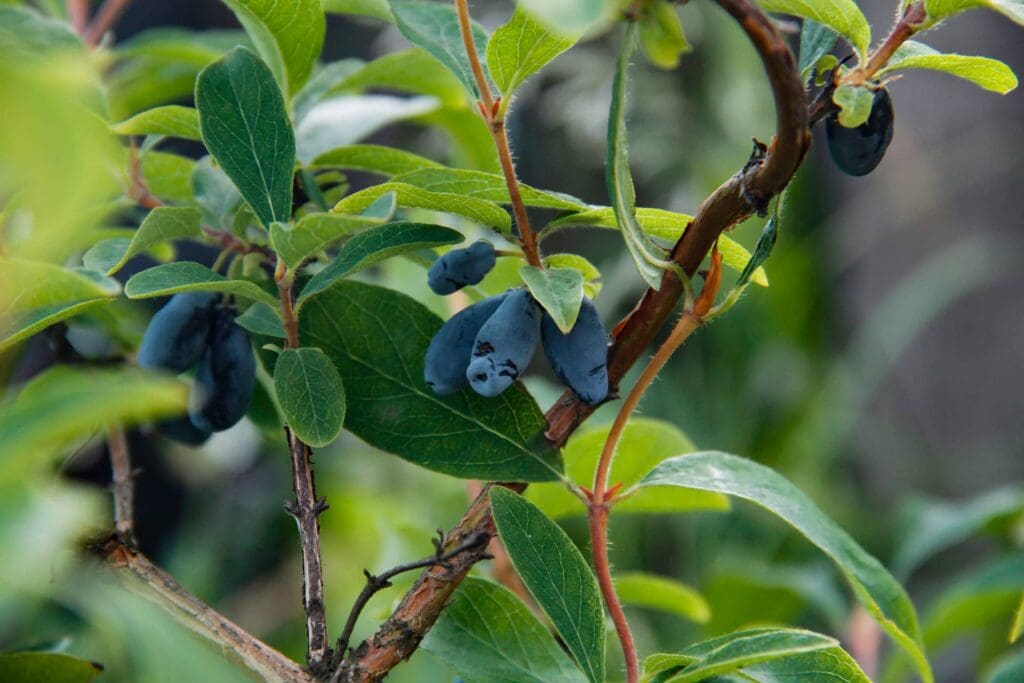

Yezberry®-Solo-Haskap
Consider your vision for growing your own fruit carefully. What will you do with the fruit? Will you eat them fresh out of hand, bake pies, jam, jellies, make conserves, freeze some for winter, or press them for cider? You won’t be disappointed if you do some research ahead of time to choose the best varieties for your needs!
New Fruit Tree Introductions
There have been great improvements in hardy fruit trees for zone 1-4 gardens in recent years. The U of S fruit breeding program has made strides in new eating and cider apples, tart cherries, haskaps, and raspberries are all excellent fruit choices for our northern gardens. New fruit varieties from Russia, like pears and sea buckthorns are good. There are new introductions in plums, blueberries, strawberries, and apricots! Rumors that we can only grow crabapples in zone 2 climates are not true! We can grow beautiful, delicious and hardy fruits right here in Alberta – that will surprise you in how good they are. We can grow apples of equal or better quality to anything you will find in the supermarket, imported from BC, Washington, or New Zealand. It’s time to get planting!
With over 70 years in the tree nursery business at Prairie Gardens, near Edmonton, Alberta – we do get a lot of questions from folks on how to plan and plant orchards in Alberta for future generations! It makes sense – we are the best source of information when choosing which cultivars of different fruit types to plant in your area. We’ve had plenty of practice in learning what grows where, in our climate.
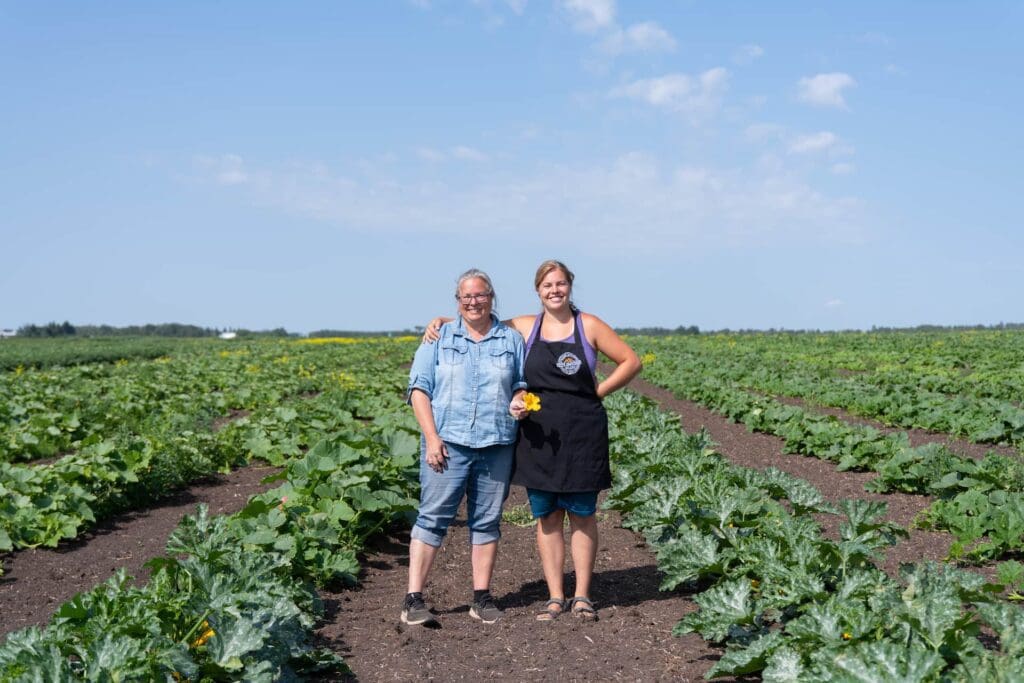

Prairie Gardens – Tam & Laurel Andersen
7 RULES OF THUMB for PLANTING FRUIT TREES IN ALBERTA
First rule of thumb
Do a little research! Start with the right tree. In the right location. Do not plant over or under utility lines. Check on mature size to allow space for growth. Plant what you want to eat!
Second rule of thumb
Pollination is critical to fruit production. You need bees and pollinating partners (a different variety of the same type – i.e. 2 apples of different varieties planted close by) for fruits and nuts, including: apples, plums, pears, haskaps, blueberries, sea buckthorns, hazelnuts and apricots. Apples will only pollinate apples; pears will only pollinate pears, and so on. Haskaps or Plums are tricky! They must bloom at the same time, and need to be compatible (ask us)! Haskaps need the right haskap. Plums need a wild plum close by. Self-fertile fruits, like tart cherries, saskatoons, currants, raspberries, and strawberries do not need a partner. They will produce fruit with just one tree or bush in the yard.
See related posts:
Precocity (Apples) 10 Earliest to Bear Apples to Pick
Growing Plums & Cherry Plums for the Prairies Zone 2-3
All About Haskaps in Edmonton & Area
Third rule of thumb
Springtime planting works! We recommend to plant up until the end of June. Yes, you can plant containerized trees in the ground any time during the summer, but after June – remember: the later in the season you plant, the slower your trees will develop, and the more vulnerable they are to hot dry weather spells later in the summer. Watering can become a challenge.
Fourth rule of thumb
If you miss Springtime Planting, planting in the Late Fall is also very effective. The exceptions are late apples like Honeycrisp, or Mount Royal Plums, which should be planted before the end of June. There is a low percentage of risk that fall planted trees may not survive, but we have planted hundreds of fruit trees in October, and have had excellent results! Compared to the risk of trying to establish a tree in the hot dog-days of August, when they are likely to succumb from heat and lack of moisture stress (if you are not committed to make sure they get watered at critical times) it is best to wait until the cool days of autumn, when dormancy begins, as the leaves turn yellow, to plant.
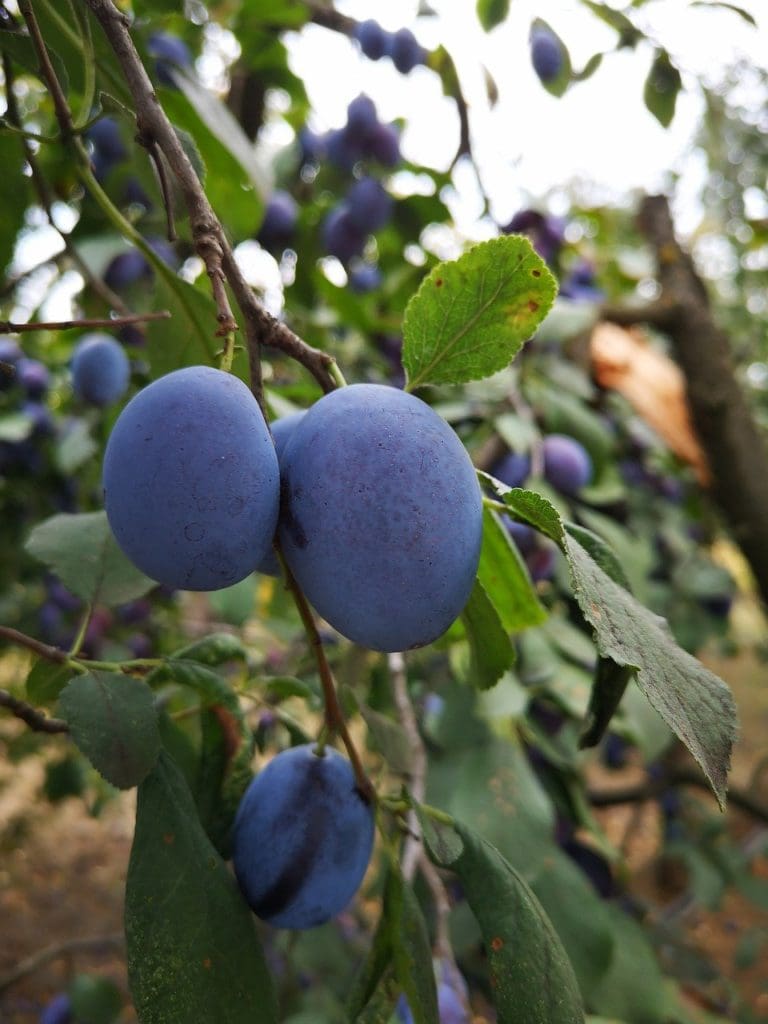

Mount Royal Plum
Roots below ground are active from April through October, and into early November here in Alberta, so dormant stock planted in September or October begins rooting before the ground freezes. And their roots get going early in the season – as soon as the ground thaws when there is lots of moisture – so you may gain a month back the following spring. It may surprise you to learn that our soil temperatures, below the snow, don’t usually get any colder than -5C, despite what the air temperature drops to. Snow cover is important! Older framework roots – deeper than 24” deep may be active all winter – as the average soil temperature ranges around 0C to plus 5C. There is ongoing research into the phenom of root growth! Mulching is wise if there is no snow cover. But we don’t recommend mulching at planting time – it is so difficult to tell if the tree roots are wet or dry for watering. Wait until fall to mulch.
Fifth rule of thumb
The hole in which each tree is to be planted should be wide enough to accommodate all of the tree’s root system easily, and deep enough to add at least 6” of topsoil under the tree’s root ball (from the pot it came in), so the top of the root ball is exactly one inch below the final grade after watering and the soil settles. If the root ball is sticking up above the ground level – that is not good – it acts like a wick and dries out too fast. If it is buried more than three includes deeper below ground, the feeder roots suffocate.
Sixth rule of thumb
Grafted or budded trees should always be planted so their union is above the soil line. You should not bury it below the surface, as the top-grafted material will also sprout roots, thereby rendering the hardy root stock below ineffective. Your tree will be rooted-in on the non-hardy grafted plant above the graft, which will winter kill.
Seventh rule of thumb
Have patience! When you plant fruit trees, you are investing in the future! Even if they are producing fruit when you buy them, they invariably revert to root development for at least 2 years after planting, at the expense of fruit production. After planting, some fruit trees don’t flower and bear fruit for 3 to 5 years, or up to 10 years (in the case of some pears or plums). But once they have reached the point where they are mature enough, and have an adequate root system – the fruiting begins!
Fruit tip: No fruit yet? Soil stress (too dry, too wet, too much nitrogen) can affect roots in two ways depending on the magnitude of the stress: It can cause plants to put out more roots or to cease their production altogether. If your trees are delayed in fruit production, they are experiencing soil stress. Researchers have discovered relationships between root growth and tree fruit loads. Trees with no fruit have more root growth than trees with fruit. Too much water and/or too much nitrogen brings on more leaves and less fruit. No bees? Bees are critical to pollination and therefor fruit set. You must plant pollinator friendly plants in your yard so bees can survive through the entire season – not just at apple blossom time. Also – late spring frosts at blossom time can kill the blossoms. Did you have a frost at blossom time?


Yellow Plum Fruit
Back to Fruit Tree Roots: There are three kinds of tree roots: pioneer, transport, and absorptive roots.
- Pioneer roots in trees are the first-order roots, which have been referred as “pioneer”, “long”, and “framework” roots. Pioneer roots develop into woody transport roots, which become the underground framework of a tree; their lifespan may last as long as the life of the tree.
- Transport roots act like plumbing systems for trees. They move the water and nutrients collected by the absorptive roots. These roots are woody and live for more than one year. Transport roots are initially formed by pioneer roots. As they become woody, they make up the framework supporting the absorptive roots, creating a structure similar to scaffolding branches. They grow quickly and become woody in weeks. These roots are located in the top 6 to 24 inches of the soil and occasionally can grow deeper 3 to 7 feet if soil conditions allow.
- Absorptive or Feeder roots are at the root tips, and take up water and nutrients. They are not woody and have a relatively short lifespan, typically from 30 to 60 days. They are white or lighter in color and the target of microbes and herbivores. These lower order roots are the most active absorptive roots because they are where the fastest metabolism occurs. Owing to their finer structures, they have the greatest amount of soil contact. They are usually located at the dripline of the established trees, in the top 6” – 15” of the soil.
- Bare-root fruit trees and berries: Always remember – a dry root is a dead root. A root exposed to air is like a fish out of water! You have only minutes before they expire! Prepare your tree planting hole first, then bring the tree out. A tree lying around with its roots exposed to sunshine and air will suffer significant transplant shock or die. Roots must be kept moist, and covered at all times prior to planting. Alternatively, submerge the tree roots into a bucket of water while you are planting, to keep the roots alive.
Root establishment:
- How to Feed and Water: Most absorptive roots are shallow, located within the top 6 to 15 inches of the soil around the drip line. That’s where we apply water and nutrients. This is also where a process called mycorrhizal colonization occurs. Mycorrhizae are created by a union of roots and specific soil-born fungi. They aid in improving plant growth, water and mineral absorption, disease suppression and drought resistance. Mycorrhizal fungi colonize roots faster than non-mycorrhizal fungi. This is especially true for roots aged 15 days or less.
- Pot-bound Trees: If you find circling roots at the bottom of the pot, this needs to be fixed before you plant the tree. Circling roots never stop circling! Several years after planting, these circling roots will begin to girdle or strangle the stem or trunk, ultimately killing the tree or shrub. Research has shown that it is best to sever roots with a sharp utility knife at four points around the container. Do not untangle the roots, or shake the soil off them, simply cutting them will solve the problem, and won’t hurt the plant. Shaking off the soil will send them into transplant shock. Don’t do it.
- How Deep do Roots Grow? Roots of trees grow down deep into the ground, both length-wise and depth-wise. Imagine the crown of the tree turned upside down underground. That’s how far roots spread. Most tree roots occupy an area underground that is two to four times the diameter of the crown of the tree but depending on the size and age of the tree – may be up to eight times. It really depends on the situation, space available, and variety of tree.
- Water-seekers: Do not plant poplar or willow close to underground water or sewer pipes, or cisterns. These water-lovers will find the water and infiltrate the systems, causing damage.
Prepare For Success: The plants that feed us best – are the ones we tend, with great care. That great care begins at planting. Once you plant a tree, you never look back, they say. It becomes a marriage of sorts. Here’s the thing, though – if you want your trees to produce fruit for you consistently year after year, you must commit to care for these trees and feed them – especially their roots, “as long as ye both shall live” in their forever homes.
Feed the Soil: You must nourish the soil that the roots continue to thrive across the decades. And you must protect the microbial network that lives beneath the surface, that creates the ecosystem for your dear friend, the apple, pear, or plum tree, will know as their home for up to a century, (or longer). Healthy soil is the key to healthy trees. It’s important to check the soil where your trees will live well ahead of time.
Topsoil is Required: On acreages, farms and older urban areas, the original topsoil, with all of it’s amazing micro-organisms, may be intact (like on our farm – where the Alberta #1 topsoil is 24” deep). More often than not, in new developments, every scrap of topsoil has been scraped off, with just an inch put back for sod. You will need to dig a big hole, twice as wide, and twice as deep as the pot or root ball, to add more topsoil before you plant; along with some compost, and add micro boost over the top to water in. These Mycorrhizal fungi colonize roots – which will supply to help your trees metabolize nutrients and resist stress and pests.
Ideal Spots: Trees all have their ideal spots they want to grow in. Some like wet feet. Some prefer well drained or sandy soil. Others are not fussy, and will grow in heavy clay, grey soil, or anywhere. We can advise you on which type of fruit best handles your particular moisture, soil and summer weather conditions, as well as which ones are best equipped for the pests and diseases endemic to your area. Advice of this kind can prevent suffering for you and your tree down the road. It’s not too early to begin gathering such information now so as to be ready for next planting season.
Micro-climates: When choosing a place to plant your trees, consider the micro-climate. Is there wind protection? Can you plant in the lee of the wind beside a building, or on the south side of a fence? If not- you will need to want to plan on adding a shelter-belt row of trees to break the winds. Fruits carry their leaf and flower buds through the winter, and buds can desiccate in the full force of the wind.
Sunlight: Fruit trees need a minimum of 6-8 hours of light a day, to all-day sun, for best harvests, so don’t plant your orchard in a shady area that sees little sun. South facing slopes can be ideal, especially as they provide good drainage. The exceptions are cranberries, blueberries, or lingonberries, which prefer some afternoon shade.
Frost: Frost is not your friend at blossom time – as the blossom’s tender pollen receptors are damaged with as little frost as one evening for a few hours below 0 C. With the exception of Haskaps – which will take a -7C frost and still produce berries. You don’t want to plant trees sensitive to cold at the bottom of hills. Frost flows downhill, like a river, to the low-lying areas to “cold-sinks”. My daughter, when she was young – called these places “cold-stinks”! The strawberry blossoms would all freeze and turn black in these frost prone zones, so there would be no strawberries there. You can usually spot these frost hollows by the way they tend to gather and hold this mist on a cold spring or fall evening. This is where you can safely plant cranberries (they don’t bloom until July), or haskaps which can tolerate a frost, but no – not ever – apricots – which bloom in April or very early May when frost is likely.
It makes sense to choose the right tree, for the right location, so when the tree reaches its mature size –it still fits the landscape. By choosing the best variety for the size of your yard, acreage, orchard or farm, and maintenance mowing device, you and the tree will have a wonderful happy relationship when they give you fruit.
Plant Right Away: Once you’ve picked up the trees you will plant from the nursery, try to get them into the ground as soon as possible (trees that come in pots with soil can be held for several days in the shade – with adequate waterings; bare root stock should be stowed in a refrigerator, or plunged immediately into a bucket of water for three or four hours ahead of planting (to a maximum of 24 hours). Any longer than that will induce root rot. If you can’t plant them, then ‘heel’ them in – so their roots are below some cool moist soil until you are ready. Remember! A dry root exposed to air is a dead root! Recovery is not possible.
Dig the hole: When digging the hole, you will plant the tree in it is a good idea to break up the soil at the bottom of the hole as best you can. Glazing the sides of a smooth round hole, however tempting, will make the tree root ball zone like a pottery pot – which will not drain and instead, holds water like a bucket. Your tree will drown! Rough-up the sides of the hole, and create fissures at the bottom – to let the water drain away properly. Throw in a shovel or two of compost to introduce living organisms and encourage good growth. But don’t add fertilizer. That comes after your tree has had a chance to become established.
Soil PH: Acidic soil: Different types of fruits and berries require different soil conditions and PH readings. Birch, for example prefer slightly acidic soil. There are some berries that must be in quite acidic soil. If you are going to take a crack at growing blueberries or lingonberries, you will need to add plenty of peatmoss (about 12” deep) over your planting area, to work in at root zone level, to drop the PH from a neutral of 7 to an acidic 4.8. Peatmoss has a PH of 4.
Trees for alkaline soil also known as “sweet” soils are those with a pH of more than 7. This is commonly caused by a high content of lime or chalk, which may also result in the soil being free draining and lower in nutrients than neutral, loamy soils. The best trees for alkaline soils are Apricot, Saskatoons, Blackberry, Hawthorn, Cotoneaster, Elaeagnus (Buffalo Berry, Wolf Willow, and Russian Olive). Not sure? Buy a PH meter – and check!
- Cotoneaster
- Snowbird Hawthorn -Photo courtesy Bron
- Black Satin Blackberry
- Wolf Willow – Photo Courtesy Brons
Planting Tip: Firm the soil at the top and be sure to add just one inch of dirt over the top of the root zone. Do not add more, as delicate feeder roots will suffocate if they are buried 3” down or more.
Bare-root Trees: If you have planted a bare-root tree, remember that approximately one-quarter of the root system was removed when the tree was dug. To compensate, remove about one-quarter of the top part of the plant to reestablish a 1:1 shoot-to-root ratio. Trees that come planted into a container do not need as much pruning; remove only broken branches, or some branch tips to encourage the limbs to break-bud and literally – branch out!
When I trained to become a horticulturalist at Olds College, professors taught us how to wiggle the tree back and forth gently as the soil is added to the hole, to make sure there are no air pockets around the roots. If the tree you are planting is bare-root, and you can see the roots may be larger on one side of the tree, than the other. It’s a good idea to situate that tree so that the biggest roots go in the ground on the side of the tree facing the prevailing winds, which are from the north-west in the Edmonton area, or due-west in southern Alberta. This will help anchor the tree as it grows.
Staking a Tree: If you are in a very windy area – you should put a stake in beside the tree – on the prevailing wind side. Just for one year – then remove it. The swaying of the tree to the wind actually builds trunk timber and strength. Prolonged support with a tree stake will weaken the trunk, and make it susceptible to breaking in the wind later. If you have planted a larger tree, and there is a danger that high winds could ‘rock the root ball’ back and forth, breaking off baby new roots, use three guy-wires, one from each direction. Again, only necessary for the first year. Take them off in year 2.
Lowest Branch to the South-west! With container grown trees, it’s hard to tell the size of the roots in the ball. In this case, we recommend planting the tree with the lowest branch to the south west – to protect and shade the tree trunk from sunscald, which can happen in early spring – when the warm sun reflects off the icy snow – late March or early April, and actually scalds the bark of the tree. The branch grows to shade the tree trunk as it matures.
Watering in: The tree is in the ground! But – you are not done yet! You must always “water the tree in”, or the task is not completed properly! A five-gallon bucketful of water for a new fruit tree, in a 5-gallon pot, isn’t too much. The idea is to make sure the tree roots have enough water to fill the air-spaces between root and soil, to make good root-soil connections – and to give enough moisture for the tree to maintain its leaf canopy to prevent planting shock.
You’re committed! Make sure your newly planted tree gets enough water as needed, but not too much. Newly planted trees need water when their roots dry out again – so you must check by poking your finger into the soil surrounding the root ball. If it feels moist – it is ok. Watering everyday will surely kill your tree, as the roots need oxygen and moisture. If it is soggy wet – there is no oxygen! Keep a close eye on it. In a week or two you’ll start to see signs of growth which indicate, as my horticultural mentor, Auntie Anne used to say, the tree has begun to “take,” signaling a lifetime relationship between it and you. Another of her famous sayings was: “You can’t bring a dead plant back to live with a water transfusion!” Evenly applied moisture is key!
How Can I Tell? If in doubt about whether it is wet or dry, use a long bamboo stake or a screwdriver to poke down deeper into the root ball. If it goes in easy – it’s wet! If you can’t get it in – it’s dry! If it is a dry spring, and your tree leaves show signs of softening, or wilting, and you’ve had less than 4 to 5 inches of rain since the trees were planted, apply 5 gallons around the base of each tree on a weekly, or semi-monthly basis. By the time a tree wilts, it is in a state of stress and extreme water depravation. Best to not let them wilt down.
Make a Water Basin: We recommend you use a hoe to make a small berm, (a small ridge of soil to make a water damn) around each tree to prevent the water from running away. As the tree grows, the root zone will expand – so don’t water the trunk of the tree – water the drip line of the tree (where the branches end), as that will be where the most important feeder roots are.
Fertilizers: If you are planting in May – use a water-soluble high phosphorus fertilizer like 15-30-15 or 9-45-15, or an organic fertilizer with a higher middle number – like 2-3-1, in a 12-inch-wide band around the root zone. Do not apply any dry granular fertilizer or bonemeal near the tree when planting. They kick-in in August – just at the wrong time – when your tree should be slowing down and going dormant.
Tree Trunk Guards: After the water has moved into the soil, add a tree guard. We learned this the hard way – as gophers moved in a stripped the bark off a dozen plum trees! Mice can do the same in the winter, underneath the snow. Rabbits can stand on the snow and reach up a lot higher than you think! A plastic tree guard, or an 18-inch to 36-inch square piece of 3/8-inch hardware cloth (formed into a circle using the 18-inch dimension as the circumference, and the 36-inch as the height – makes an excellent guard. Bury the bottom of the guard 1 to 2 inches into the soil or into finely crushed stone, which helps to reduce weeds and rodent damage when it is spread around the base of the tree.
Animal and human protection: Protect your tree from gophers, rabbits, hoes, and well-meaning whipper snippers. If the bark gets scraped off, weed eatered off, or eaten off your tree, the damage is done. The tree will have to spend valuable time and resources on healing. If it’s completely girdled, it will never recover. I have often used a recycled 1- or 2-gallon pot, with the bottom cut off, and sliced around up the side to go around the trunk at the bottom of the tree – to protect from heavier machinery – like too-close-to-the-tree hand push lawnmowers or ride-on lawn mowers.
Feel free to visit us online at www.PrairieGardens.org to send us an email – or give us a call if you have more questions! We love to share what we know and it would be our pleasure to help you get off to a good start with your tree planting endeavors!
See Our Fruit Trees and Order Yours Today!
-
Dwarf Snow Apple
$59.95 Read more -
Dwarf Wolf River Apple
$95.00 Read more -
Dwarf Rouville Apple
$59.95 Read more -
Meteor Sour Cherry
$75.00 Add to cart -
Goldcot Apricot
$125.00 Read more -
Harlayne Apricot
$85.00 Read more -
Black Nanking Cherry
$34.95 Add to cart
